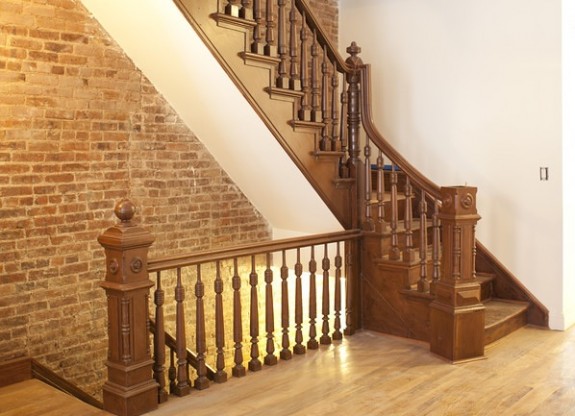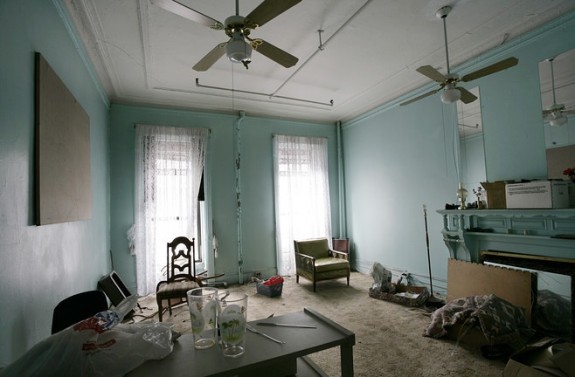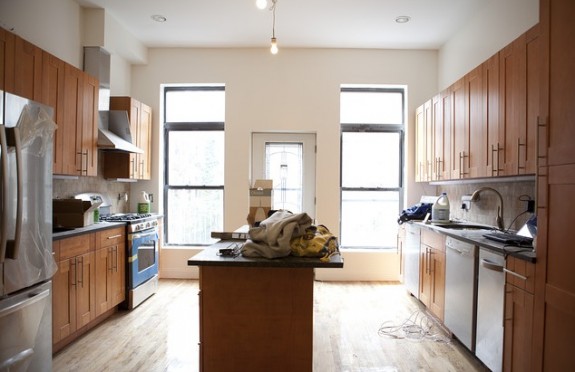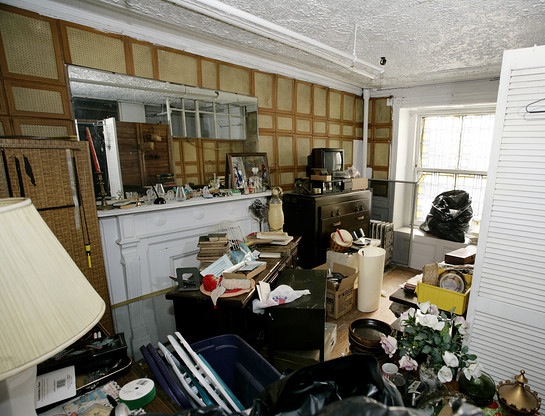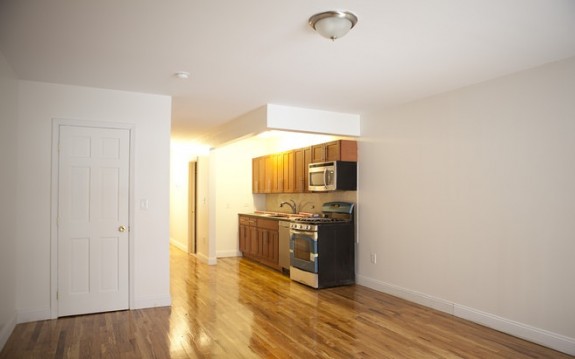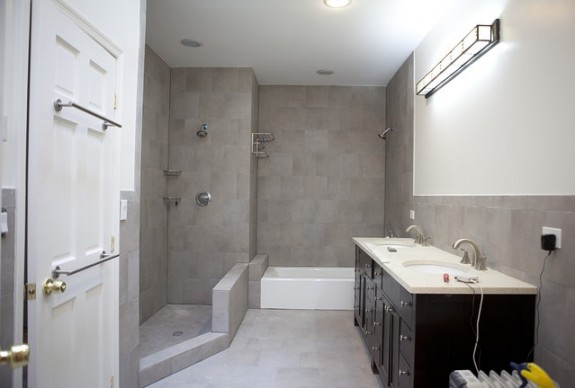At our mortgage closing the other day our loan officer made an interesting comment – “there are no jumbo rehab loans”. Jumbo loans are really big mortgages that are bigger than Fannie Mae or Freddy Mac are willing to insure. They’re purely a bank product. People can still get regular jumbo mortgages, but jumbo rehab loans simply don’t exist – the banks think they’re too risky. The line between “conforming” and “jumbo” is determined by Fannie Mae and Freddy Mac. Currently conforming loans in New York max out at $729,75o for a one family, $934,200 for a two family, and $1,129,250 for a three family. Where this comes into play vis-à-vis Harlem townhouse shells is that it limits who can buy and renovate shells and how the townhouses are configured. Let’s take a few examples and see how this plays out…
Harlem’s little townhouses – 12.5′ x 53 x 4 stories
Dotted all around Harlem are 12 1/2 foot townhouses where the original developer fit two homes on one 25 foot lot. These have 2,650 sq. ft. including the walls, 2,350 sq. ft. inside the walls (586 per floor).
If we assume $165/sq. ft. for an average shell, that puts the purchase price around $450K. Then add $530K ($200/sq. ft.) for a nice renovation and the total cost will be just under $1M.
Owners are probably going to want the entire house for themselves – 2,350 sq. ft. isn’t that much when you subtract the space taken by the staircases, etc. Since only $730K can be financed with a conforming mortgage that means the potential buyer needs nearly $300K in cash to make it work.
If the buyer converts it to two family then only about $100,000 of cash is needed, but then the buyer gets a pretty small space and won’t get much rental income since the unit will be pretty small.
The standard “smaller” Harlem townhouse – 16′ x 50′ x 4 stories
All over Harlem you see 16 footers that are roughly 16′ x 50′ x 4 stories (3200 sq. ft. total, 2880 sq. ft. internal sq. ft. internal, 720 sq. ft. per floor). These will probably cost $525K to purchase (plus or minus depending on condition and location), and cost $650K to renovate – so $1.175M in total investment.
Chances are the buyer will want to configure it as a two family – so they’ll need about $250,000 in cash to put down (minimum).
If they configure it as 3 family their unit will be less than 1,500 sq. ft. and they’ll lose the back yard and only have a roof deck (much less desirable for the owner). But then they only need about $50K down and they can go with low-money down FHA-backed 203(k) loan.
The popular 18 footers – 18′ x 55′ x 4 stories
18 footers are popular because they’re wide enough to have floor through rentals which are popular with developers. But putting developers into the equation ups the prices. They have about 3,950 sq. ft. (3,600 interior, 900 per floor). With developers in the picture I’d expect the cost to be around $710K for the building and $790K for the renovation – so $1.5M total investment.
Configured as a two family the owner would get 2,700 sq. ft. but would need $575K in cash to make it happen.
Configured as three family the owner gets 1,800 sq. ft., but loses the back yard and still needs $375K in cash to pull it off.
While a developer might make it 4 family, there’s really no point. The increased taxes on 4 family (compared to 3 family) and having just a small apartment make it not worth while to the owner.
The coveted 25 footers – 25′ x 52′ x 4 stories
25 footers are just elegant. The space in them is incredible – 5,200 sq. ft. total (4,800 internal, 1,200 per floor). Typically 25 footers have 12+ foot ceilings on the parlor floor so they just feel cavernous. They’re wonderful houses. But with that space comes higher cost… Probably $900K for the building, plus $1M for renovation for a total cost of about $1.9M.
The most spectacular configuration is an owner’s triplex over a ground floor rental. That would give the owner a 3,600 sq. ft., 6 bedroom house with substantial rental income from a legal two bedroom apartment. But they would need $1M in cash since the 2 family rehab loan maxes out at $935K.
The other configuration is two floor-thru tenants over an owner’s duplex. But with that configuration the owner still needs to come up with $775K in cash.
5 story townhouses
In each of the scenarios above it’s possible you could buy a 5 story townhouse instead of the more common 4 story. In some cases it makes adding a unit easier and more desirable since the owner’s unit will have an additional floor. But it ups purchase and renovation costs.
The bottom line
The bottom line is that the lack of jumbo rehab mortgages means that potential buyers either need a lot of cash or they need to be OK with not having a very big owner’s unit. That severely limits the pool of people who realistically are suited for rehabbing buildings. The other thing to note is that this is a bigger problem for bigger townhouses since the costs go up and there aren’t jumbo mortgages to offset the increased costs. Even the little townhouses can easily exceed the max amounts for conforming mortgages.
If you look at some of the posts I’ve had on what things are selling for you’ll notice the gap between shells and livable townhouses is bigger than you might think. I think part of that spread is due to what I just described above – the potential buyers for shells are limited because the loan amounts for rehab mortgages are limited.
But it gets worse…
The problem looming on the horizon is that politicians want to scale back Fannie Mae and Freddy Mac. If that happens it means no more Fannie and Freddy mortgages. There are proposals to make this happen over the next two to ten years. NYC already has increased loan amounts because we’re in a high cost area. As Fannie and Freddie get scaled back all of that will just go away. In fact people think 30 year fixed rate mortgages will go away if Fannie and Freddie are eliminated or severely scaled back.
The politicians who are advocating getting rid of Fannie and Freddie aren’t thinking about what it will mean to neighborhoods with blighted buildings – but it will have a huge effect. They understandably want to stop the federal government from taking on such big risks, but rehabbing blighted neighborhoods is a risk I think it’s appropriate for governments to take on since even if the mortgages default the community benefits. If Fanny and Freddy go away it’s possible next to nothing will get rehabbed in Harlem – or the rehabs will only be done by developers – not by homeowners who are investing themselves in the community. I’m not saying Fannie and Freddie are perfect, but very few Harlem townhouse shells would get rehabbed without them.
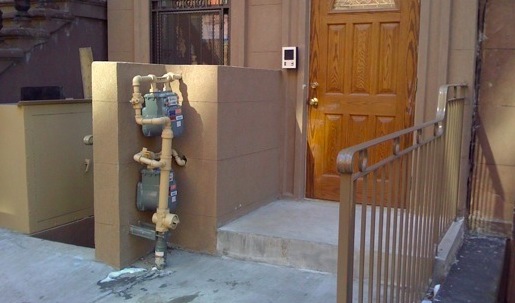

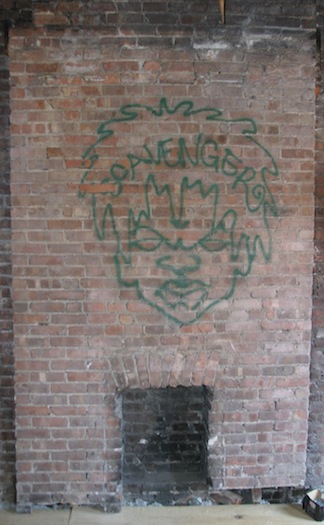 As the floors have been going in we we’ve seen that there’s some pretty cool graffiti on the top floor. Well, the top floor is in, so we can finally get a good picture of it…
As the floors have been going in we we’ve seen that there’s some pretty cool graffiti on the top floor. Well, the top floor is in, so we can finally get a good picture of it…



 So they say they spent $1.22M in total. Let’s call it $1.25M since I’m sure there were at least some costs that weren’t reported. That means their total investment was $325/sq. ft. which is very close to what I estimate our cost will be when we’re done – the difference is they’re moving in after 13 months and we’ll move in after 21 months (if things go smoothly).
So they say they spent $1.22M in total. Let’s call it $1.25M since I’m sure there were at least some costs that weren’t reported. That means their total investment was $325/sq. ft. which is very close to what I estimate our cost will be when we’re done – the difference is they’re moving in after 13 months and we’ll move in after 21 months (if things go smoothly).